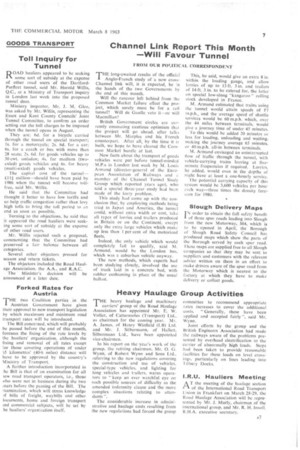Channel Link Report This Month —Will Favour Tunnel
Page 9

If you've noticed an error in this article please click here to report it so we can fix it.
FROM OUR POI HICAL CORRESPONDENT
THE long-awaited results of the official Anglo-French study of a new crossChannel link will, it is expected, be ;.n the hands of the two Governments by the end of this month.
Will the rancour left behind from the Common Market failure affect the project, which surely must be for a rail tunnel? Will de Gaulle veto it—or Will Macmillan?
British Government circles are currently emanating cautious optimism that the project will go ahead, after talks between Mr. Marples and his French counterpart. After all, by the time it is built, we hope to have cleared the Common Market hurdle at last.
New facts about the transport of goods vehicles were put before tunnel-minded M.P.s in London last week by i. Louis Armand (director-general of the European Association of Railways and a member of the Channel Tunnel Study Group which reported years ago), who said a special three-year study had been made of the lorry problem.
This study had come up with the conclusion that, by employing methods being tried in Japan and America, the tunnel could, without extra width or cost, take all types of lorries and trailers produced in Britain or on the Continent, except only the extra large vehicles which make up less than I per cent of the motorized fleets.
Indeed, the only vehicle which would completely fail to qualify, said M. Armand, would be the London bus. which was a suburban vehicle anyway.
The new Methods, which experts had been studying closely, involved the use of track laid in a concrete bed, with rubber cushioning in place of the usual ballast. This, he said, would give an extra 8 in. within the loading gauge, and allow lorries of up to 13 ft. 3 in. and trailers of 14 ft. 3 in. to be catered for, the latter on special low-slung "kangaroo" rolling stock developed in France,
M. Armand estimated that trains using the tunnel would attain speeds of F7 m.p.h., and the average speed of shuttle services would be 60 m.p.h. which, over the 44 miles between terminals, would give a journey, time of under 45 minutes.
To this would be added 20 minutes or less for loading, unloading and waiting, making the journey average 65 minutes, or 40 m.p.h. all-in between terminals.
M. Armand envisaged an uninterrupted flow of traffic through the tunnel, with vehicle-carrying trains leaving at fiveminute frequencies if required. Lorries, he added, would even in the depths of night have at least a one-hourly service.
The potential carrying capacity of this system would he 3,600 vehicles per hour each way—three times the density foreseen for 1980.




















































































































